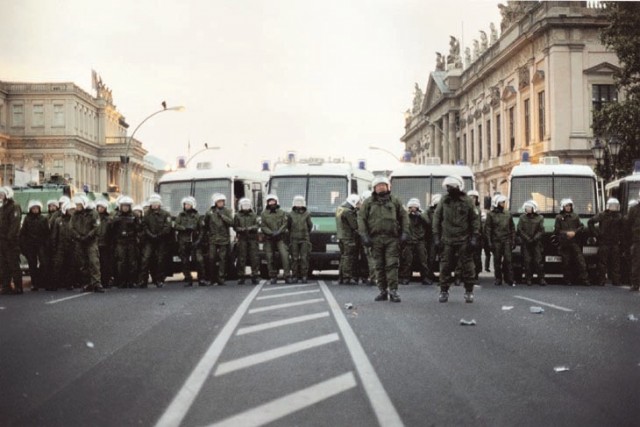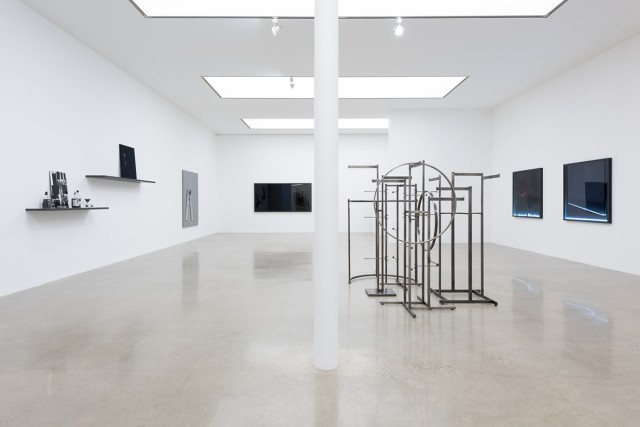“Protest culture and art allow us to bring up uncomfortable questions”: The Big Interview: Josephine Meckseper
Currently enjoying her second solo show at Timothy Taylor gallery, the German, New York-based installation artist talks us through her current and key influences — including Jean-Luc Godard’s dripping red paint, Duchamp’s semen paintings and the LA riots…
Josephine Meckseper’s (b. 1964) films and large-scale installations — made from carefully selected and obsessionally collected found objects, like toilet brushes, junk mail and pictures of Karl Marx — have been exhibited in and collected by museums worldwide, including the Whitney Museum of American Art, the Museum of Modern Art, the Guggenheim Museum (New York), the Migros Museum (Zurich), and many more.
Born in Lilienthal, Germany, the artist moved to America in 1992 to study and now lives and works in New York. Consequently, her work at times reflects and records aspects of US culture from a European perspective; Meckseper is well-known for her extensive documentation of the Bush administration’s 2003 invasion of Iraq, where she travelled around America and Europe filming and photographing police and activists at anti-war demonstrations.
The Double Negative: Could you describe your new solo exhibition at Timothy Taylor (London) to us in your own words? Including one or two key pieces?
Josephine Meckseper: The works in this exhibition form an abstracted narrative by means of objects. Metal wall vitrines, illuminated by fluorescent lights, contain jammed window blinds and toilet seat rugs, that together with black paint and business ties, resemble a medieval coat of arms. The 1964 movie Becket, with Richard Burton as archbishop Thomas Becket and Peter O’Toole as King Henry the II, cited in these works, becomes a signifier for the human struggle suspended between an exertion of power and love.

The material aspect of analogue cinematography – the grey tint of the emulsion-coated negative, the square film perforation, and the layering of frames – is echoed throughout the works in the exhibition by means of sculptural and wall-mounted glass and Plexi works. Traces of red paint splashes on translucent surfaces invoke Jean-Luc Godard’s early experimental short Film-Tract No 1968 [pictured, top], where he and a French artist filmed red paint dripping down a French flag, as an act of solidarity with the leftist anti-government movements.
The layering of surfaces in the works in this exhibition also recall Goodbye to Language (2014), filmed by Godard in separation shots using double-exposure 3D images filmed with parallax, barely perceivable to the human eye.
The shelf work Here and Elsewhere reflects on social interactions within the art world, manifested in the form of half empty shot glasses, bottles, ashtrays and sperm, employing the object instead of the image to create a narrative. The shelf also eludes to Duchamp’s Paysage fautif [semen painted on black satin] and The Pharmacy, recalling the bottles of coloured liquids in pharmacy windows.
You refer to Rosalind Krauss’s statement in the PR text, “that sculpture is a medium peculiarly located at the juncture between stillness and motion” — why was this interpretation important to you?
The objects and sculptures in my show serve as an analogue recording device. Found materials, detritus from the street, junk mail and ephemera from social interactions create a ‘record’ of a temporal environment or situation. In some ways shifting the act of Duchampian ‘appropriation’ to a principle of ‘recycling’ and salvaging the object/image.

The implicit cinematic and narrative aspect that leads to the accumulation of the found objects is played out in purely static form. The ‘recorded’ image is here limited to a faint ‘reflection’. A taxidermy New York city rat, for example, is juxtaposed with a grey Plexi screen that functions both as a large film transparency and as a window frame, creating a three-dimensional still image of the animalistic antagonist.
You often refer to the female form in your work — photos of blonde models in CDU-CSU (2001); mannequins in Untitled (End Democracy) (2005) — do these references continue at Timothy Taylor?
References to the body in my work mainly relate to a Marxist argument about capitalism being the second iteration of the original Christian notion of the ‘fall of man.’ The ‘explicitness’ of advertising and commercials can only be seen as signifiers of universal capitalist semantics.
My new works are investigating ‘platonic’ objects, such as bathroom rugs, clothing racks, liquor bottles and underwear – to exemplify Hegel’s dynamic Platonism: “generic universality, differentiated specificity, and individual singularity as the three syllogistic terms which, by their interrelations, explain organic and inorganic being.” This raises questions such as; Does what we produce culturally have an accumulative aspect, or is it just a process without ultimate consequences? Does the existence of an object also include its non-existence?
Protest culture is at the forefront of social debate and in the media right now… what is it, however, that holds an allure/interest for you as an artist? What is your evaluation?
My work is fundamentally conceptual, but in many ways influenced by my upbringing in the political climate of the 1970s in Germany, as well as having studied at the California Institute of the Arts in the early ’90s, coinciding with the Rodney King riots in Los Angeles. My work to various degrees reflects the role of the artist in our current consumer society and points to the instability of capitalism and Post-Fordian society.

Protest culture and art allow us to bring up uncomfortable questions.
Your studio in Chinatown, NY, was described by Frieze as a ‘hotchpotch of consumer offerings and emporia‘ … similarly, found materials obviously take centre stage in your exhibitions. How would you describe the act of collecting objects in your practice?
I might have a storage room full of strange objects, but it’s more of a recycling station. I don’t really collect anything per se. To me, free floating objects and the works that they subsequently may constitute, merely mirror the dialectic between ‘being as a whole’ and ‘specific beings’, as suggested by Heidegger. The drama and tension between the objects creates the essence of what ‘time’ or ‘the thing’ is. The conflict and specific ‘un-specificness’ of the objects in my work points to the question whether there is a ‘world as a whole’, or just an infinite chain of correlations between matter and objects.
As told to Laura Robertson
See Josephine Meckseper’s solo exhibition at Timothy Taylor gallery, London, until Saturday 12 December 2015





